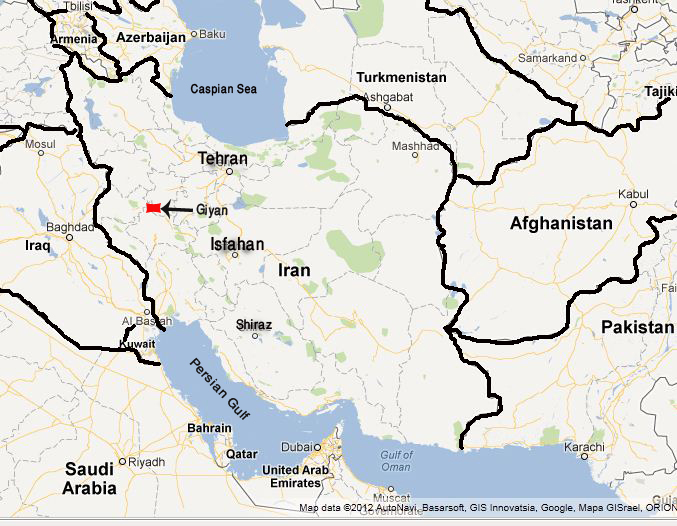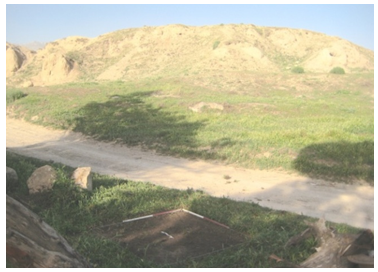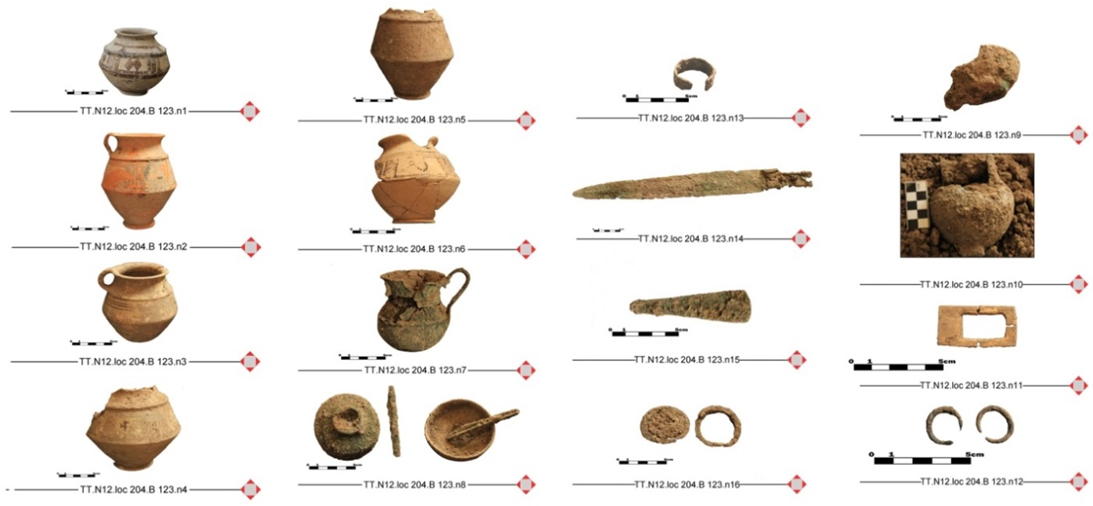-
Paper Information
- Paper Submission
-
Journal Information
- About This Journal
- Editorial Board
- Current Issue
- Archive
- Author Guidelines
- Contact Us
Archaeology
2013; 2(3): 47-51
doi:10.5923/j.archaeology.20130203.01
A newly-found diagnostic Bronze-Age Burial from Tapeh Giyan, Nahavand, Iran
Esmail Hemati Azandaryani1, Ali Khaksar2
1M. A. student at Tarbiat Modares University
2Senior expert of The Cultural Heritage Organization of Hamadan Province
Correspondence to: Esmail Hemati Azandaryani, M. A. student at Tarbiat Modares University.
| Email: |  |
Copyright © 2012 Scientific & Academic Publishing. All Rights Reserved.
Tapeh Giyan in Western Iran, which is well known to the archaeological academia, is one of the most important prehistoric mounds in Central Zagros which has always been noticed by both Iranian and foreign archaeologists. The last season of field works at Tapeh Giyan was done under Ali Khaksar in the spring and summer of 2012 in order to determine its boundaries. For this purpose, 27 test pits were dug all over the mound, and in trench no. 12, a distinctive burial was discovered. Since none of the 122 graves excavated by the French expedition over the years 1931 and 1932 were documented, the excavation continued on this newfound grave; it was entitled no. 123. Its burial’s corpse’s position is a combination of bent and supine position, and its mouth is abnormally wide open; also, there are 19 funerary objects buried with it. In the present study, we are going to discuss the very unique burial position of this grave together with its historic and comparative aspects.
Keywords: Iran, Central Zagros, Tapeh Giyan, Burial, Bronze Age
Cite this paper: Esmail Hemati Azandaryani, Ali Khaksar, A newly-found diagnostic Bronze-Age Burial from Tapeh Giyan, Nahavand, Iran, Archaeology, Vol. 2 No. 3, 2013, pp. 47-51. doi: 10.5923/j.archaeology.20130203.01.
Article Outline
1. Introduction
- Tapeh Giyan is a well-known archaeological site located 12 km from the west of Nahavand and 70 km from the south of Hamadan city, in the marginal parts of a small town with the same name. This archaeological site was excavated by French archaeologists (Contenau and Ghirshman) over the years 1931-1932 and its results were published in 1935 [1]. These excavations culminated in gaining a set of artifacts dating to the chalcolithic period; (early first millennium B.C.E). This apparently proves the fact that there is no gap or chasm in the sequence of Tapeh Giyan from the fifth to the early first millennium B.C.E. [2]. The stratigraphic system that used by Ghirshman had applied as well as the results he had obtained through his excavations at Giyan all used to be a dating criterion for Western Iran for a long period of time. After that, Giyan became less important till it was once again excavated in 27 test pits in 2012 in a research program for delimitating the mound and determining its boundaries [3]. In the course of conducting this research program, the true area of the mound was determined. The mound spreads towards the south, east and also southeast, and it continues to the beds beneath streets and houses; this was confirmed by an in-situ burial located in the outer parts of mound’s boundaries dating back to the middle Bronze Age. The burial was to excavated and studied owing to the fact that the other 122 burials were not completely/fully documented by the French expedition.
2. Geographical Location
- As it was mentioned above Tapeh Giyan is situated in the Northern peripheral parts of the town, and it meets residential units in the south. This mound is 350 m long and 150 m wide, and it is also 17 m higher than the surface of the adjacent lands. Lastly, the average height of the mound is 1600 m above the sea level.
3. Research Background
- Jacque De Morgan (1896 C.E.) was one of the first researchers who investigated the region of Lurestan. After a while, Ernst Herzfeld (1929 C.E.) explored Gilevaran and Giyan Mounds in the Eastern Lurestan. Subsequently, a French expedition under George Contenau and Roman Ghrishman began to excavate Tape Giyan in 1931-32 and Tape Jamshidi in 1933. The reports of the both above-mentioned excavations were published in 1935[4]. In addition, the excavation of Tapeh Babajan[5][6], Tapeh Abdul Hossein[7], Temple Laodicea[8][9] and the Archaeological survey in Nahavand[10] should be mentioned.
 | Plate 1. Tapeh Giyan location in Iran Map |
4. Discussion
- After Chalcolithic Period in Iran's prehistoric periods a new period named Bronze Age began. The time span of this period was between 3000-1500 B.C.E. Bronze Age is actually one of the most remarkable periods in the Iranian prehistoric chronology; this period is known with its evolutions in human societies including some major changes in different fields such as cultural, social, artistic and economic spheres in comparison with the other time periods. In this period, the long-term burial tradition of interring corpses under the floors is abandoned and a new tradition according to which cemeteries were built outside residential and manufacturing areas was replaced[11].One of the reliable well-built archaeological databases which provide the most information about spiritual aspects of prehistoric cultures is graves and funerary traditions of the prehistoric societies. Moreover, we could regard graves and their funerary objects as live images of specific moments of life in past societies. In addition, graves and burial styles give researchers a lot of information about chronology, ethnography, anthropology, social and economic relationships, and social ranks and hierarchy[Ibid]. From the scholars' point of view, social archaeology is in fact studying past societies on the basis of their material remains[12]. One of the commonest and most efficient methods which can help with reconstructing the past as one of archaeological objectives is studying burials and their findings[13].Tapeh Giyan is one of the most prominent archaeological sites in Central Zagros from which artifacts from 5th to 1st millennia have been reported in the course of archaeological excavations. This mound’s excavations could undoubtedly bridge the gap between non-scientific/unsystematic and scientific/systematic archaeological excavations in Iran. At that time, the system of stratigraphy (was not interpreted in the same way) it does now, and what was regarded really important during excavation was finding the origin of a particular pottery from the region of Giyan as well as the bronze artifacts of Lurestan[14].Considering the fact that most information about Tapeh Giyan has been yielded from its burials, it cannot be reliable enough from the stratigraphic point of view; however, it’s been about 50 years that the chronology covering mid-3rd millennium to 2nd millennium B.C.E. in western Iran has been established based on Tapeh Giyan’s excavations[15]. Incidentally, the ceramic assemblage recovered from this mound has had a key role in dividing it into 5 main levels showing five main time periods[16].Overall, 122 graves have been excavated in scattered spots of Tapeh Giyan at different depths during the previous excavations at Giyan. 119 graves in the depth of 9.5 m. from the mound's surface, and 3 graves in depths of 11.5, 13 and 14; one in each, have been dug[Ibid]. These graves are in form of simple elliptical pits in the ground. The children's skeletons have been buried in almost large jars. The corpse body and skeleton have been bent and it seems that this position pattern had not been obligatory[17].In the course of this season's excavation, an accompanied burial was found in test pit number 12 in the depth of 200 cm from the mound surface.
 | Plate 2. The location of TT.N12 |
 | Plate 3. How funerary gifts buried with the skeleton |
 | Plate 4. Certain funerary tradition in Tapeh Giyan, the rings put on the two papillae on the lower jaw joint |
 | Plate 5. Objects found from the grave (Gifts from the grave) |
- The notable point about this burial is the skeleton's position pattern; this skeleton's upper part along with its pelvis is both in a complete supine position, and its mouth is unnaturally open (pl. 4, 5). Considering the existence of two bronze rings at the joint of the upper and the lower jaws (mandible and maxilla), we could conclude that some changes have been exerted on the primary status of the burial. The jaw bone and the teeth are completely sound except for the premolars which have traces of wearing on them; all this makes us presume that this person would do an activity with them when he had been alive (pl.5). His legs are tucked in toward his stomach on the right side of his pelvis. The toes and ankles of his both legs were below the right side of pelvis, and the pelvis itself had been dislocated after burial due to external pressures. The bone of left leg's femur was located on the pelvis, and the femur's head had been situated on the right hand's elbow as well (pl. 2).According to the conducted studies, parallels to this burial - in which the bust and pelvis are in supine position and legs are bent- had already been reported from graves no. 4, 5, and 7 of level 3 at Tapeh Jamshidi (a mound 15 km from Tapeh Giyan; excavated by the French expedition during the same years with Tapeh Giyan); among all these three above-mentioned graves, the skeleton of grave no. 4 bears the highest extent of resemblance with that of Tapeh Giyan [22].
5. Conclusions
- According to the palaeoanthropological studies, this skeleton belongs to a hefty man aging 35- 40 years old. This skeleton, despite being almost well-preserved, bears some evidence which indicates a number of changes applied in the primary burial including lack of some hand and foot phalanges as well as the existence of the rings put on the two papillae on the lower jaw joint (Pl. 2). It is highly likely that these rings have caused the mouth to remain open, which could imply sort of burial tradition (Pl.4). According to Ghrishman’s excavations in 1933 and 1934 in the Tapeh Giyan, the earrings have been among the funerary objects of men. In addition, the rings couldn't be earrings in that in addition to the rings, there are two earrings in the grave (Pl. 4, 5). Because of the abundant muscles and vessels existed between upper and lower jaws, the rings could not be placed there in a living human. Therefore, the rings must have been placed in these places after death intentionally. Furthermore, the symmetrical position of the rings in the two papillae on the lower jaw joint (Pl.4, 5), the impossibility of putting and removing the rings easily in this place and also having no evidence of the natural post- depositional processes, in other cases such as earrings, and the object place on the collar bone (Pl. 2, 4), are the reason for rejecting the natural post-depositional processes and accidental disturbance.Ceramic wares constitute the majority of the gifts. These wares are all morphologically typified as Giyan (IV, III) and Godin types which all date back to mid-third millennium through late- second millennium B.C.E (Pl.3). Existence of metal objects in this grave and studying the type of bronze alloy utilized in these objects' structures shows that the method and technique used in producing these dishes and pots has been lost wax method, and beside that hammering has been applied in making the other metal objects.Finally, on the basis of the historic-comparative studies, and also with considering the chronology of prehistoric cultures at Tapeh Giyan, we can infer that this burial belongs to (middle) Bronze Age and dates back to a period of time from 2500 to 2000 B.C.E.
ACKNOWLEDGMENTS
- We would like to thank M. Janjan, A. Saremi, A. A. Arab, M. Shaabani, and H. khanali, Kh. Zarini, A. Motarjem and M. Aliei for reading and editing the manuscript.
 Abstract
Abstract Reference
Reference Full-Text PDF
Full-Text PDF Full-text HTML
Full-text HTML